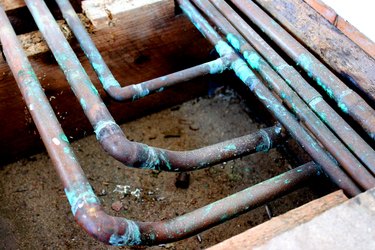
Copper piping can develop a green or greenish-blue discoloration on the pipe. This discoloration can easily be misconstrued as mold when in fact it is oxidation. This oxidation can be directly related to the soldering of copper, which is why it is more prevalent at the joints. There may be oxidation in other locations, and this is a result of prolonged exposure to water and humidity. Cleaning off this oxidation will help prevent corrosion and failure of the copper pipes in the future.
How Copper Pipes Turn Green
Video of the Day
Copper has been used as a replacement for lead to convey water since ancient Egyptian and Roman times. Since the 1940s, copper has been used for plumbing around the world and is still used to this day. The green patina may look beautiful on a copper wind chime, but to plumbers, it is a sign of a problem.
Video of the Day
During the installation of a plumbing system, there are steps that are taken to solder copper joints. One of these is the use of a flux, which is very acidic. While the plumber is heating up the copper joint to solder, the flux helps the solder find its way in, forming a water-tight bond. If the excess flux is not thoroughly cleaned after the soldering is complete, it will form the greenish-blue oxidation and possibly eat away at the copper joint over time. Many plumbers and piping installers have stopped soldering pipes in favor of more modern methods that do not require the use of acidic fluxes.
Green Oxidation and Leaks
Not only is the green formation on the pipe from a step forgotten during installation, but it can also be from a leak. Some leaks may not have any sign of water but can be a hint of moisture that is coming from the piping. No piping material is perfect, and copper, even though it has been a proven method of water conveyance for thousands of years, is no exception. When the moisture meets the air surrounding the copper pipe, it forms a green oxidation. This is where you may have a leak that developed from either a slightly leaky soldered joint or even a pinhole in the middle of a length of pipe.
Cleaning Oxidized Copper Pipes
The green oxidation is not any more harmful than rust is on a car fender. Over time, either will cause an issue with the metal but will not cause any health problems for people. Just as rust on your car's fender needs to be addressed, so does the green oxidation on the pipe before things get worse.
Mix equal parts white vinegar, flour, baking soda, and salt to form a paste. Rub the paste to cover the green oxidized area. Allow it to dry for a minimum of 30 minutes. Using soapy water, thoroughly wipe the paste from the copper pipe. The soap will neutralize the vinegar's acidity. Be sure to clean the affected area well with the soapy cloth and wipe the area dry after cleaning or the green oxidation will form again.
Copper Pipes in a Damp Basement
One place that may contain moldy-looking copper piping is a damp basement or crawl space. This combination of dampness and air can have severe adverse effects on any home, from mold and mildew to oxidation of copper piping. After taking care of your damp basement, you'll want to clean the green oxidation that has formed on the copper piping. Keeping air from reacting with the moisture will help eliminate oxidation. To help keep air from your copper pipes, insulate the piping to keep air and moisture separated. Insulation will also keep condensation from forming on the cold water pipe as well as save energy.